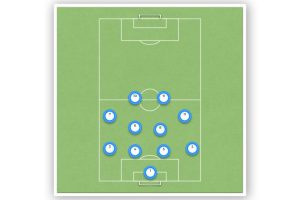Soccer Tactics: A Comprehensive List of Winning Strategies for Coaches
Soccer tactics are essential for any coach to master if they want to win games. As a soccer coach, I know that having a solid understanding of the different tactics can help my team succeed on the field. Whether you’re coaching a youth team or a professional team, knowing the right tactics can make all the difference in the outcome of a game.
There are several soccer tactics that coaches should know about to help their team win games. Some of the most popular tactics include Tiki-Taka, Park the Bus, Counter-Attack, The High Press, The Long Ball, Total Football, and Gegenpressing. Each of these tactics has its own unique advantages and disadvantages, and it’s up to the coach to decide which one to use based on their team’s strengths and weaknesses.
In this article, I’ll be taking a closer look at each of these tactics and providing examples of how they can be used effectively on the field. By the end of this article, you’ll have a better understanding of the different soccer tactics available to you as a coach, and you’ll be able to make more informed decisions about which tactics to use to help your team win games.
From Counter-attack, Long Ball, High Press to the 4-4-2. What Style of Play will your Team Have?
Soccer tactics are the strategic plans that coaches and players use to outmaneuver their opponents during a game. There are various types of soccer tactics that teams can employ, each with its own unique strengths and weaknesses. Some tactics focus on maintaining possession of the ball, while others prioritize quick counter-attacks or a high-pressing defensive strategy. Understanding and utilizing different tactics can help teams gain a competitive edge and win more games.
| Tactics | Description |
|---|---|
| Tiki-Taka | A possession-based style of play that emphasizes short, quick passes and movement off the ball. |
| Park the Bus | A defensive tactic that involves packing the penalty area with players to prevent the opposing team from scoring. |
| Counter-Attack | A tactic that involves quickly transitioning from defense to offense in order to catch the opposing team off guard. |
| The High Press | A tactic that involves pressuring the opposing team high up the field in order to win the ball back quickly and create scoring opportunities. |
| The Long Ball | A tactic that involves bypassing the midfield and playing long balls over the top in order to get in behind the opposing defense. |
| Total Football | A tactic that emphasizes fluid, interchangeable positions and encourages all players to contribute to both defense and offense. |
| Gegenpressing | A tactic that involves immediately pressing the opposing team after losing possession in order to win the ball back quickly and create scoring opportunities. |
Defensive Tactics
As a coach, I know that defense is just as important as offense when it comes to winning games. Here are two key defensive tactics that every coach should know about:
Man-to-Man Marking
Man-to-man marking is a defensive tactic in which each defender is assigned to mark a specific opposing player. This can be an effective way to shut down the opposing team’s star players and limit their scoring opportunities. However, man-to-man marking requires a lot of communication and coordination between defenders, and if one defender fails to mark their assigned player, it can leave gaps in the defense.
Zone Defense
Zone defense is a defensive tactic in which defenders are assigned to specific areas of the field rather than specific players. This can be an effective way to cover more ground and prevent the opposing team from making dangerous passes or getting behind the defense. However, zone defense requires a lot of discipline and coordination, as defenders must work together to cover their assigned areas and prevent gaps from forming.
| Man-to-Man Marking | Zone Defense |
|---|---|
| Each defender marks a specific opposing player | Defenders are assigned to specific areas of the field |
| Effective at shutting down star players | Effective at covering more ground |
| Requires communication and coordination | Requires discipline and coordination |
As a coach, it’s important to understand the strengths and weaknesses of both man-to-man marking and zone defense, and to choose the tactic that best suits your team and the situation at hand. By mastering these defensive tactics, you can help your team win more games and keep your opponents from scoring.
Offensive Tactics
As a coach, I know that scoring goals is essential to winning games. Offensive tactics are all about creating opportunities to score, and there are two primary approaches: Possession Play and Counter-Attacking.
Possession Play
Possession play is all about controlling the ball and maintaining possession for extended periods. This tactic requires players to be comfortable on the ball and to pass and move quickly. By keeping the ball, the team can tire out the opposition, create scoring opportunities, and control the tempo of the game.
To implement possession play, coaches should encourage players to keep the ball on the ground and to pass and move quickly. Players should be comfortable receiving the ball under pressure and should look to create triangles of support around the ball carrier. By doing so, the team can maintain possession and create scoring opportunities.
| Key Points | Examples |
|---|---|
| Control the ball | Pass and move quickly |
| Create triangles of support | Keep the ball on the ground |
Counter-Attacking
Counter-attacking is all about quickly transitioning from defense to attack. This tactic requires players to be fast, direct, and clinical in front of goal. By quickly moving the ball upfield, the team can catch the opposition off guard and create scoring opportunities.
To implement counter-attacking, coaches should encourage players to quickly transition from defense to attack. Players should look to play long balls behind the opposition defense or to dribble past defenders to create scoring opportunities. By doing so, the team can create quick goalscoring opportunities.
| Key Points | Examples |
|---|---|
| Quickly transition from defense to attack | Play long balls behind the defense |
| Dribble past defenders | Be fast and clinical in front of goal |
Set Piece Tactics
Corner Kicks
Corner kicks are a great opportunity to score a goal. When taking a corner kick, I like to have two players positioned near the goalkeeper to distract them and create space for the other players. Additionally, I like to have one player positioned at the near post, one at the far post, and one in the center of the box. This creates multiple options for the player taking the corner kick.
Another tactic is to have one player run towards the ball and then fake a shot or pass, which can create confusion and space for another player to make a run and receive a pass.
Free Kicks
Free kicks are a great opportunity to score a goal or create a scoring chance. When taking a free kick, I like to have a few players positioned near the ball to create confusion and distract the opponents. Additionally, I like to have one or two players making runs towards the goal to create space and draw defenders away from the ball.
Another tactic is to have one player fake a shot or pass, which can create confusion and space for another player to make a run and receive a pass. It’s important to practice different free kick strategies in training so that the players are comfortable executing them in a game.
Penalty Kicks
Penalty kicks are a high-pressure situation, but there are a few tactics that can increase the chances of scoring. One tactic is to have the player taking the kick choose a spot to aim for and practice hitting that spot consistently in training. Another tactic is to have the goalkeeper study the opposing team’s penalty kick takers and try to anticipate where they will aim.
It’s also important to have a few players positioned near the penalty spot to follow up on any rebounds or deflections. In high-pressure situations like penalty kicks, it’s important to stay calm and focused and trust in the tactics and training.
| Set Piece | Tactics |
|---|---|
| Corner Kicks | Position players to create multiple options, have one player fake a shot or pass |
| Free Kicks | Position players to create confusion, have one or two players making runs towards the goal, have one player fake a shot or pass |
| Penalty Kicks | Choose a spot to aim for and practice hitting that spot consistently, have a few players positioned near the penalty spot to follow up on any rebounds or deflections, have the goalkeeper study the opposing team’s penalty kick takers and try to anticipate where they will aim |
Soccer Tactics Coaches Should Know
As a soccer coach, I know that having a good understanding of tactics is crucial to winning games. Here are some soccer tactics that I believe all coaches should know:
Substitutions and Formations
Substitutions and formations are two key areas where coaches can make tactical decisions that can have a big impact on the outcome of a game. Here are some strategies for making substitutions and varying formations:
Substitution Strategies
One of the most important things to keep in mind when making substitutions is the timing. Substitutions can be made at any time during the game, but coaches need to be strategic about when they make them. For example, if a team is losing and needs to score a goal, the coach might bring on an attacking player to try to create more chances. On the other hand, if a team is winning and wants to protect their lead, the coach might bring on a defensive player to help shore up the back line.
Another important consideration when making substitutions is the player’s fitness level. If a player is tired or carrying an injury, the coach might want to bring them off to give them a rest or prevent further injury. On the other hand, if a player is performing well and has lots of energy, the coach might want to keep them on the field to maintain the team’s momentum.
Formation Variations
Formations are another area where coaches can make tactical decisions that can have a big impact on the game. Different formations can be used to emphasize different aspects of the game, such as attacking or defending. Here are some common formations:
| Formation | Description |
|---|---|
| 4-4-2 | A standard formation with four defenders, four midfielders, and two strikers. |
| 4-3-3 | A more attacking formation with four defenders, three midfielders, and three strikers. |
| 3-5-2 | A formation with three defenders, five midfielders, and two strikers. This formation can be used to control the midfield. |
| 5-3-2 | A defensive formation with five defenders, three midfielders, and two strikers. This formation can be used to protect a lead. |
Coaches can also make variations within formations to suit their team’s strengths and weaknesses. For example, a coach might switch from a 4-4-2 to a 4-3-3 during a game to add more attacking options.
Conclusion
In conclusion, understanding soccer tactics is crucial for coaches to win games. From Tiki-Taka to Gegenpressing, coaches must have a solid foundation in a variety of tactics to be successful. By establishing a playing system that links a team’s formation to a particular style of play, coaches can create a winning strategy that fits their team’s strengths and weaknesses.
Coaches should also be familiar with different drills and training methods to teach their team the necessary skills. They should run demonstrations and provide guidance and strategies for winning matches without interrupting their wider coaching philosophy and player development plans.
Overall, the key to success is having a well-rounded approach that takes into account both the team’s strengths and weaknesses, as well as the strengths and weaknesses of the opposing team. By using a combination of tactics and strategies, coaches can create a winning formula that leads their team to victory.






